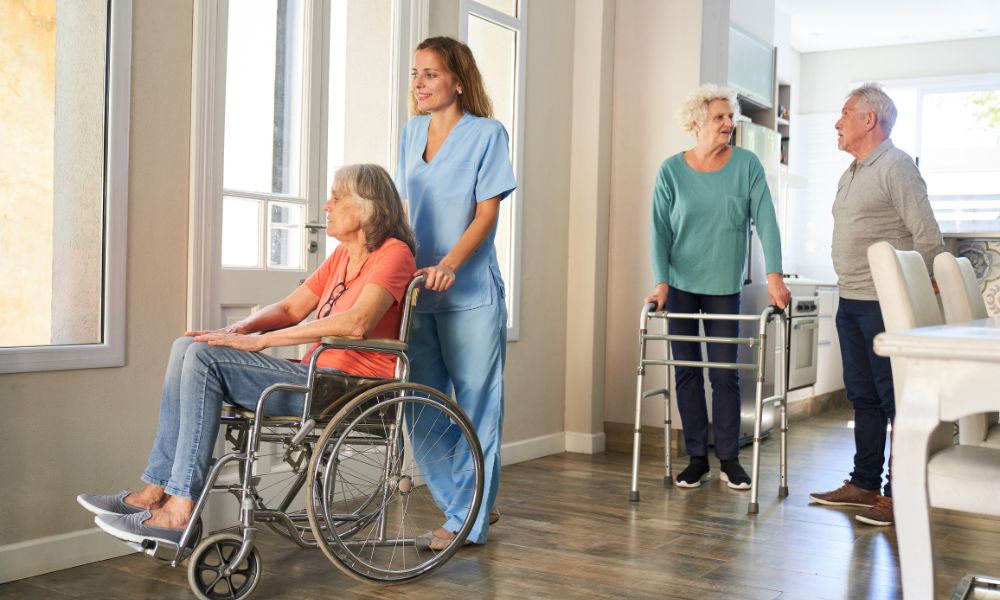As individuals age, their ability to move freely and safely can often diminish. Challenges such as chronic pain, recovering from surgery, and severe disabilities can significantly impact mobility. These challenges highlight the importance of mobility aids, which provide stability, reduce pain, and enhance the quality of life for older adults.
Mobility aids are crucial for seniors experiencing difficulty walking or maintaining balance. These devices, such as walkers, canes, and wheelchairs, are not just tools; they are gateways to greater freedom and independence. Properly selected and used, mobility aids can prevent falls and further injury, helping seniors navigate their environments more safely.
Types of Mobility Aids
As seniors face different challenges in mobility, the range of available mobility devices is broad, catering to specific needs and preferences. These tools not only enhance mobility but also offer significant support and independence.
Walker and canes are essential for those needing more stability and those with slight balance issues. Wheelchairs are necessary for seniors with limited mobility or who cannot stand for long periods. While mobility scooters are best for those who can sit comfortably but need assistance over long distances.
Factors to Consider Before Choosing a Mobility Aid
Selecting the right mobility aid involves more than just picking any device from a mobility shop. Consulting with a medical professional or physical therapist can help determine which aid best matches one’s physical capabilities and medical conditions. For example, individuals with sufficient upper body strength might opt for manual wheelchairs, while those with lower body weakness might be better suited for power wheelchairs.
Next to consider is your budget constraints. Mobility aids range from relatively inexpensive canes to more costly power wheelchairs and scooters. It’s important to consider both the initial purchase and potential maintenance costs.
Walkers: A Comprehensive Guide
Walkers are a fundamental mobility aid for many seniors. Here’s what you need to know about walking aids and how to use them safely:
- Standard Walkers: A walking aid with simple frame designs without wheels, requiring lifting to move.
- Rolling Walkers: This type is equipped with wheels at the front, they allow a more fluid motion.
- Four-Wheeled Walkers: This kind offers wheels on all legs and typically includes seats and baskets.
The choice of walker depends on the user’s strength, balance, and typical environments they navigate. For instance, a standard walker offers more stability, while a four-wheeled walker is better for those capable of maintaining balance but require a seat for resting.
Proper Usage and Safety Tips
To ensure safety and effectiveness, it’s important to adjust the walker to the correct height, ensuring the handles align with the user’s wrist when their arms hang at their sides. Training on proper techniques to maneuver through different terrains can prevent improper or excessive use, which might lead to injuries or less effectiveness.
Canes: Supportive Tools for Mobility
Canes are versatile walking aids designed to provide balance support, reduce pain, and decrease the load on lower extremities. Types of canes include:
- Single-point Canes: For basic support and are ideal for those who need slight help with balance.
- Quad Canes: Equipped with four legs, these canes provide more stability and are suitable for individuals who require more support than a single-point cane offers.
- Walking Sticks: Often used for less stability issues and can be a stylish choice for those with minimal support needs.
Choosing the right cane involves considering several factors such as body weight, the extent of support needed, and the hand grip strength of the user. Canes should be of the correct height; the top should reach the wrist when the arm is at rest to prevent excess pressure on the shoulders and arms.
Techniques for Safe Use
Proper training on cane usage is vital to avoid further injury. Techniques include holding the cane on the stronger side of the body and moving the cane simultaneously with the opposite leg. This helps maintain a natural gait and ensures the user’s weight is distributed more evenly, offering more stability and confidence in each step.
Wheelchairs: Enhancing Mobility and Independence
Choosing between manual and electric wheelchairs often depends on the user’s upper body strength and general physical condition. Manual wheelchairs require sufficient upper body strength and are generally lighter and more portable, whereas an electric wheelchair is powered by batteries, ideal for those with limited strength and stamina.
When it comes to customizing wheelchairs, comfort and proper fit are paramount. This includes adjusting foot plates and armrests, and ensuring adequate cushioning. For individuals with severe disabilities or permanent disabilities, specialized seating like reclining or tilt-in-space options can be optimal for pressure relief and skin integrity.
Tips for Maneuvering Wheelchairs
Learning to maneuver a wheelchair effectively takes practice. It’s important to know how to navigate tight spaces, use ramps safely, and manage different surfaces. For manual wheelchair users, mastering techniques to lift front wheels can aid in overcoming small obstacles.
Mobility Scooters: Freedom to Explore
Mobility scooters vary widely in terms of design and functionality. From compact, three-wheel models ideal for indoor use to robust four-wheel models for outdoor terrain, understanding the specific features of each model helps in making an informed decision.
When selecting a mobility scooter, consider how and where it will be used. Important factors include the scooter’s weight capacity, ease of transportation, and whether it can handle uneven terrain. Additionally, consider the battery range to ensure it aligns with the user’s daily activities and distance requirements.
Safety Guidelines
Safety is paramount when using a mobility scooter. Always adhere to the manufacturer’s guidelines, use recommended safety modifications, and practice in safe, controlled environments before venturing into more complex areas. Regular maintenance checks are also significant to ensure the scooter’s reliability and safety over time.
Assistive Devices Beyond Basic Mobility Aids
In addition to the typical mobility aids, there are several assistive devices designed to enhance safety and independence within the home environment. Grab bars and handrails are essential for those with limited mobility, providing support and stability around the house, especially in bathrooms.
Transfer benches and shower chairs help in safely entering and exiting the bathtub, reducing the risk of falls in slippery environments. Lift chairs, which are powered to assist in standing from a seated position, offer an invaluable aid for those with limited strength or balance, providing not just comfort but also preserving autonomy in their living spaces.
Maintaining Independence with Mobility Aids
Maintaining independence as mobility changes can be challenging, but embracing advanced technology can greatly enhance mobility. Today, many mobility devices are equipped with features like GPS tracking, emergency alerts, and even AI-powered navigation systems that can adapt to various terrains and obstacles.
Overcoming mobility challenges also involves strategic thinking: simplifying home layouts, keeping essential items within easy reach, and staying informed about new mobility device advancements are all crucial strategies. Furthermore, regular exercise tailored to individual capabilities is helpful for improving strength and mobility, helping seniors maintain as much independence as possible.
Financial Assistance and Resources for Mobility Aids
Navigating the financial aspects of acquiring mobility aids can be overwhelming, but there are numerous resources available to help. Medicare and Medicaid often cover part of the cost of mobility aids like wheelchairs and walkers, depending on medical necessity and the specifics of the coverage plan. Veterans may also receive benefits that cover equipment and support services through the VA, recognizing the unique needs of those who have served.
Beyond governmental assistance, many community organizations offer grants and donations to individuals in need, ensuring that those who require mobility aids have access to the appropriate resources. Seeking out local and national programs can provide financial support and access to high-quality equipment.
Overcoming Stigma and Embracing Assistance
Dealing with mobility challenges often comes with emotional barriers, including feelings of loss, frustration, or embarrassment due to the perceived stigma associated with mobility aids. It is vital to address these feelings openly and promote positive attitudes towards the use of such aids.
Highlighting stories of independence and improved quality of life can help shift perceptions and showcase mobility aids as tools of freedom rather than signs of weakness. Furthermore, fostering supportive communities, both online and in person, can empower individuals to share experiences, advice, and encouragement, reinforcing a more inclusive and understanding environment for those facing mobility issues.
The Role of Caregivers and Family Support
Caregivers and family members play a pivotal role in the lives of those using mobility aids. Providing emotional support is fundamental, as it can significantly impact the user’s confidence and willingness to use such aids. Family and caregivers can also assist with the practical aspects of mobility aid usage, from navigating new devices to maintaining them.
Furthermore, understanding options for respite care is essential for caregivers to manage their well-being, ensuring they have the necessary breaks and support to continue their caregiving roles effectively. The combined emotional, practical, and professional support from caregivers and family not only enhances the mobility aid user’s quality of life but also reinforces a network of care that benefits all involved.
Summary: Empowering Seniors to Navigate Mobility Challenges
The selection and use of mobility aids for seniors are vital for maintaining independence, safety, and quality of life. From understanding the different types of mobility aids like walkers, canes, wheelchairs, and mobility scooters to addressing the emotional and practical aspects of their use, it’s important to consider each individual’s specific needs.
Embracing technological advancements and supporting both users and caregivers through resources like respite care and community support can significantly enhance the effectiveness of mobility aids. By fostering positive attitudes and providing robust support networks, we can help seniors navigate their mobility challenges more confidently and live their lives with dignity and freedom.
Discover Personal Care Services for Seniors with Mobility Challenges










